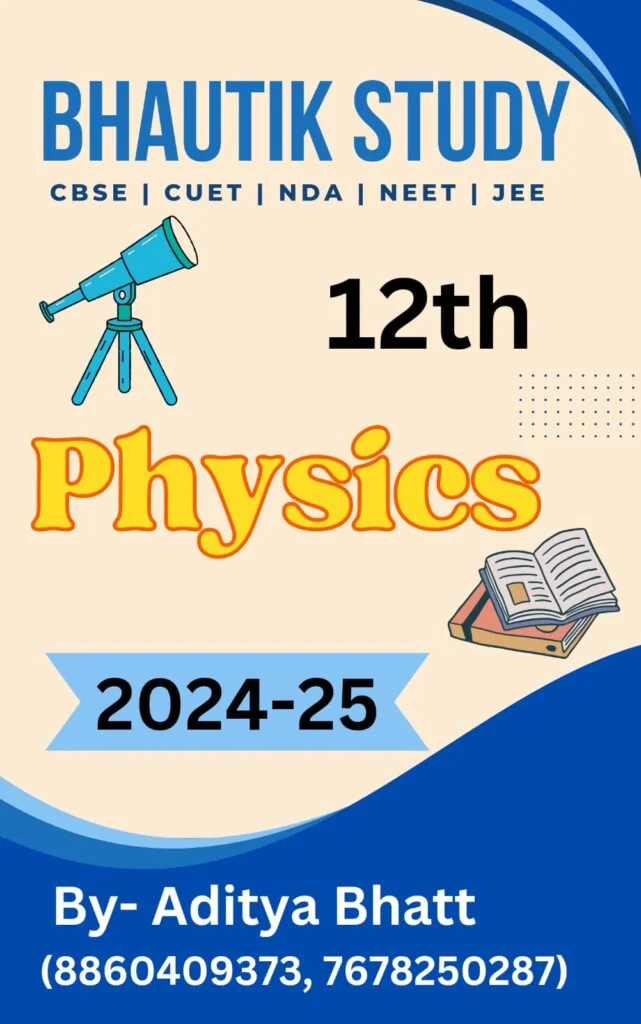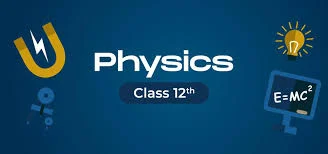Table of Contents
ToggleClass 12 Physics Syllabus, Papers, Notes, Question Bank
Prepare for CBSE class 12 exams with ease! Find sample papers, revision notes, previous year question bank, and more on our Bhautik Study platform. Good luck with your studies!
Bhautik Study Books For Selection Point of View.......


CBSE Class 12 Physics Syllabus 2024-25
The Central Board of Secondary Education, popularly known as CBSE, is responsible for creating the CBSE Class 12 Physics Syllabus and conducting the exam. Going through the syllabus will help students to know the topics they are going to study in Physics during the academic year. The list of physics experiments, which includes every aspect of the practical syllabus, is also included in the PDF.
Class 12 physics Syllabus in CBSE, 2024–2025 PDF
The syllabus for Class 12 Physics at CBSE, including the number of periods needed to complete each unit and the marking system, is provided below.
Physics Syllabus for Class 12 in CBSE, 2024–25
Nine units make up the CBSE Syllabus for Physics in Class 12, as shown in the table below.
Time: 3 Hours
Max Marks: 70
| Unit No. | Name of Unit | No. of Periods | Marks |
| Unit–I | Electrostatics | 26 | 16 |
| Chapter–1: Electric Charges and Fields | |||
| Chapter–2: Electrostatic Potential and Capacitance | |||
| Unit-II | Current Electricity | 18 | |
| Chapter–3: Current Electricity | |||
| Unit-III | Magnetic Effects of Current and Magnetism | 25 | 17 |
| Chapter–4: Moving Charges and Magnetism | |||
| Chapter–5: Magnetism and Matter | |||
| Unit-IV | Electromagnetic Induction and Alternating Currents | 24 | |
| Chapter–6: Electromagnetic Induction | |||
| Chapter–7: Alternating Current | |||
| Unit–V | Electromagnetic Waves | 04 | 18 |
| Chapter–8: Electromagnetic Waves | |||
| Unit–VI | Optics | 30 | |
| Chapter–9: Ray Optics and Optical Instruments | |||
| Chapter–10: Wave Optics | |||
| Unit–VII | Dual Nature of Radiation and Matter | 08 | 12 |
| Chapter–11: Dual Nature of Radiation and Matter | |||
| Unit–VIII | Atoms and Nuclei | 15 | |
| Chapter–12: Atoms | |||
| Chapter–13: Nuclei | |||
| Unit–IX | Electronic Devices | 10 | 07 |
| Chapter–14: Semiconductor Electronics: Materials, Devices and Simple Circuits | |||
| Total | 160 | 70 |
Students can also go through the CBSE Class 12 PHYSICS Syllabus to know the topics to be studied for the other subjects.
CBSE Class 12 Physics Syllabus for Practical
List of Experiments for Class 12 Physics Practical: Section A
- To determine resistivity of two / three wires by plotting a graph between potential difference versus current.
- To find the resistance of a given wire / standard resistor using metre bridge.
- To verify the laws of combination (series) of resistances using a metre bridge.
OR
To verify the laws of combination (parallel) of resistances using a metre bridge - To determine the resistance of a galvanometer by half-deflection method and to find its figure of merit.
- To convert the given galvanometer (of known resistance and figure of merit) into a voltmeter of desired range and to verify the same.
OR
To convert the given galvanometer (of known resistance and figure of merit) into an ammeter of desired range and to verify the same. - To find the frequency of AC mains with a sonometer.
CBSE Class 12 Physics Syllabus for Practical: Activities Assigned
- To measure the resistance and impedance of an inductor with or without iron core.
- To measure resistance, voltage (AC/DC), current (AC) and check continuity of a given circuit using multimeter.
- To assemble a household circuit comprising three bulbs, three (on/off) switches, a fuse and a power source.
- To assemble the components of a given electrical circuit.
- To study the variation in potential drop with length of a wire for a steady current.
- To draw the diagram of a given open circuit comprising at least a battery, resistor/rheostat, key, ammeter and voltmeter. Mark the components that are not connected in proper order and correct the circuit and also the circuit diagram.
List of Experiments for Class 12 Physics Practical: Section B
- To find the value of v for different values of u in case of a concave mirror and to find the focal length.
- To find the focal length of a convex mirror, using a convex lens.
- To find the focal length of a convex lens by plotting graphs between u and v or between 1/u and 1/v.
- To find the focal length of a convex mirror, using a convex lens.
- To determine the angle of minimum deviation for a given prism by plotting a graph between angle of incidence and angle of deviation.
- To determine the refractive index of a glass slab using a travelling microscope.
- To find the refractive index of a liquid by using a convex lens and plane mirror.
- To find the refractive index of a liquid using a concave mirror and a plane mirror.
- To draw the I-V characteristic curve for a p-n junction in forward and reverse bias.
CBSE Syllabus for Class 12 Physics: Activities Assigned
- To identify a diode, an LED, a resistor and a capacitor from a mixed collection of such items.
- Use of multimeter to see the unidirectional flow of current in case of a diode and an LED and check whether a given electronic component (e.g., diode) is in working order.
- To study effect of intensity of light (by varying distance of the source) on an LDR.
- To observe refraction and lateral deviation of a beam of light incident obliquely on a glass slab.
- To observe diffraction of light due to a thin slit.
- To study the nature and size of the image formed by a (i) convex lens, (ii) concave mirror, on a screen by using a candle and a screen (for different distances of the candle from the lens/mirror).
- To obtain a lens combination with the specified focal length by using two lenses from the given set of lenses.